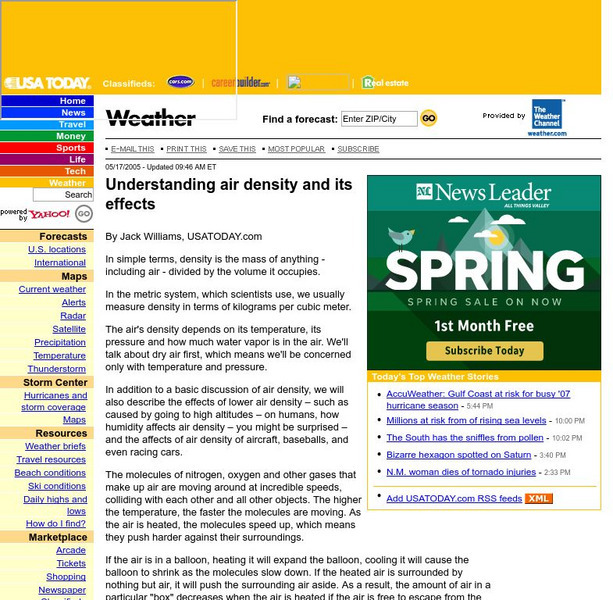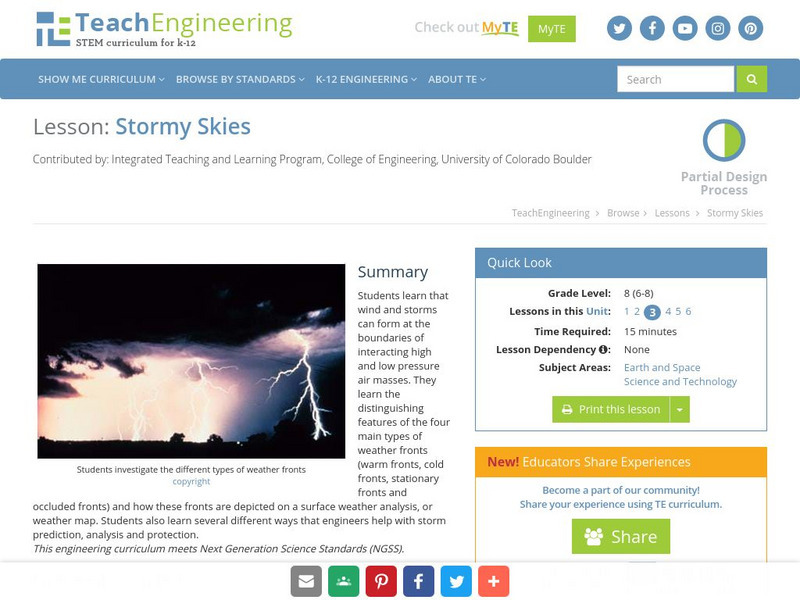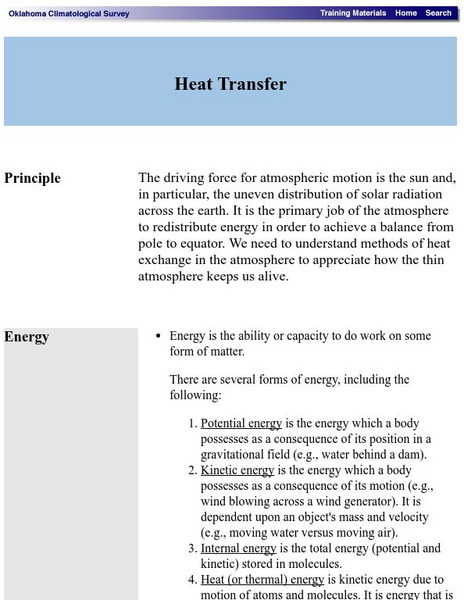Hi, what do you want to do?
eSchool Today
E School Today: Your Cool Facts and Tips on Wind
Learn all about wind, what it is, words used to describe wind, the different types, the coriolis effect, different types of breezes, and how wind is measured.
USA Today
Usa Today: Understanding Air Density and Its Effects
In simple terms, density is the mass of anything - including air - divided by the volume it occupies. In the metric system, which scientists use, we usually measure density in terms of kilograms per cubic meter. The air's density depends...
TeachEngineering
Teach Engineering: Estimating Buoyancy
Students learn that buoyancy is responsible for making boats, hot air balloons and weather balloons float. They calculate whether or not a boat or balloon will float, and calculate the volume needed to make a balloon or boat of a certain...
Oklahoma Mesonet
University of Oklahoma: Overview of Meteorology
The University of Oklahoma explores numerous types of weather and atmospheric changes, as well as the reasons behind them. Content details the four seasons, common meteorological variables, the vertical structure of the atmosphere, how...
NOAA
Noaa: Weather Systems and Patterns
Imagine our weather if Earth were completely motionless, had a flat dry landscape and an un-tilted axis. This, of course, is not the case; if it were, the weather would be much different. The local weather that impacts our daily lives...
ClassFlow
Class Flow: Frontal Depressions
[Free Registration/Login Required] A flipchart showing the separate stages of a frontal depression with reference to the weather charts that plot them, diagrams of the air masses that are moved around in them, and also of the cloud...
TeachEngineering
Teach Engineering: Stormy Skies
Learners learn that wind and storms can form at the boundaries of interacting high and low pressure air masses. They learn the distinguishing features of the four main types of weather fronts (warm fronts, cold fronts, stationary fronts...
Science Education Resource Center at Carleton College
Serc: Hands on Meteorology
A collection of interactive concept models and active learning materials for teaching meteorology that illustrate conceptually difficult processes in atmospheric science. Active learning exercises are provided as guided instruction to...
TeachEngineering
Teach Engineering: Tornado!
Students learn about tornadoes - their basic characteristics, damage and occurrences. Students are introduced to the ways that engineers consider strong winds, specifically tornadoes, in their design of structures. Also, students learn...
Other
Live Science: What Is a Jet Stream?
Jet streams are like rivers of wind high above in the atmosphere. These slim strips of strong winds have a huge influence on climate, as they can push air masses around and affect weather patterns.
Oklahoma Mesonet
Oklahoma Climatological Survey: Heat Transfer
A discussion from the Oklahoma Climatological Survey of the thermal factors effecting the movement of air masses in the atmosphere. Numerous topics such as methods of heat transfer, latent heat, phase changes (including sublimation and...
Science Struck
Science Struck: Important Facts About the Stationary Front
Read about how a stationary air front forms when warm and cold air masses meet but neither can overpower the other. Explains what its characteristics are and the impact it can have on weather conditions.
Idaho State University
Global Wind Systems [Pdf]
A great description of the global scale circulation and heat energy. Discusses a single-cell model, a three-cell model, jet streams and more.
Curated OER
Physical geography.net: Introduction to the Atmosphere
A very detailed description of air masses, how they move and interact, and what weather takes place when this happens.
















